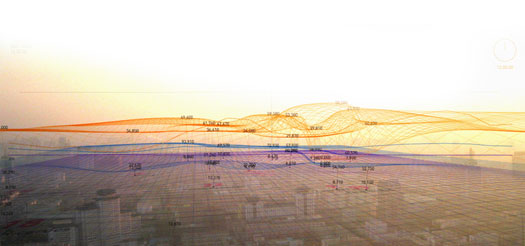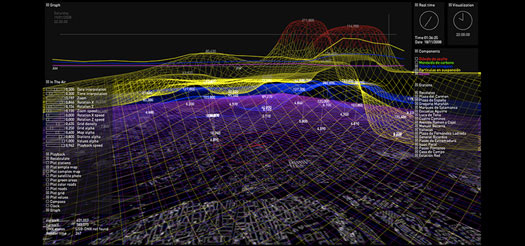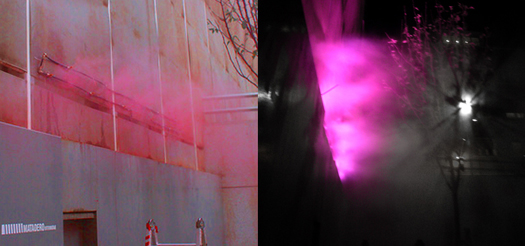
Ever since we organized Doors of Perception 3 on the theme "info-eco" in 1995, we've been preoccupied by the dilemma of environmental data. Our world is awash in eco information, we concluded then, but starved of meaning.
In the worlds of science and policy, hundreds of organizations churn out a flood of reports, graphs, studies, punditry — and lists — but our collective behaviour does not seem to change at all.

What would it take, we asked, to monitor and measure our planet’s true condition — its vital signs — in real time.
Over the years since then, a variety of sometimes beautiful perceptual aids has been designed to help us understand the conditon of the invisible natural systems that surround us. The latest, In the Air, is a visualization project which aims to make visible the microscopic and invisible agents of Madrid´s air (gases, particles, pollen, diseases, etc), to see how they perform, react and interact with the rest of the city.
The Madrid team, tracks five of the key pollutants that most detrimentally effect health and quality of life:
Sulfur dioxide (SO2) Carbon monoxide (CO) Nitrogen oxide (NO) Particulate PM10 and Ozone (03.)
As well as the visualization, In The Air includes a prototype “diffuse façade” at in Medialab-Prado. There, water vapor diffusors inform passers how much of each component in the air.

[The water vapour mildly cleans the air as and the the water dye/colorant is organic — so the installation does not add contaminants to the atmosphere].
The next step is to integrate the prototype into the entire facade of a building. At this scale multiple pollutants could be monitored and displayed at the same time, allowing for more complexity in the visualization. The building would become "a 24 hour active indicator of environmental conditions, blurring architecture with atmosphere, informing and mediating the bodies that come into contact with it."
In the Air is on display at Medialab-Prado in Madrid through January 11th. Its creator is Nerea Calvillo "along with the best team possible."


Comments [1]
I'm skeptical about your fascinating theory that dyes aren't toxic if they're organic. Did you mean that they're organic compounds or grown organically? Are they dyes food colorants? If so, people can have unhealthy reactions. And seriously, who wants to breathe pink vapors of unknown origin? I find it all too ironic.
11.30.10
07:19